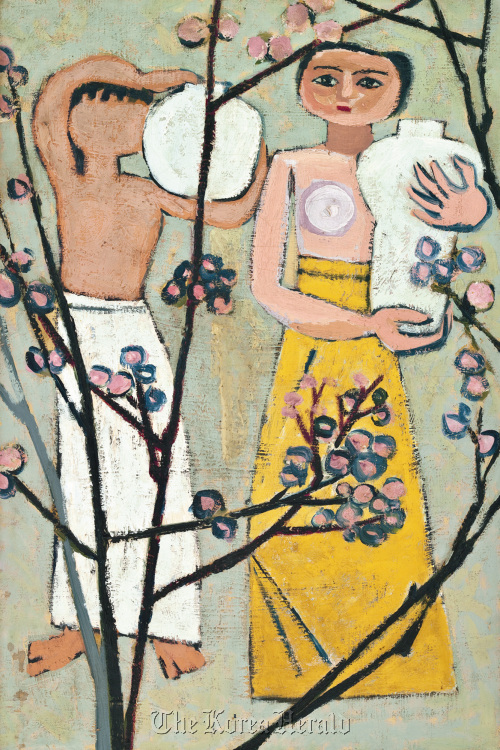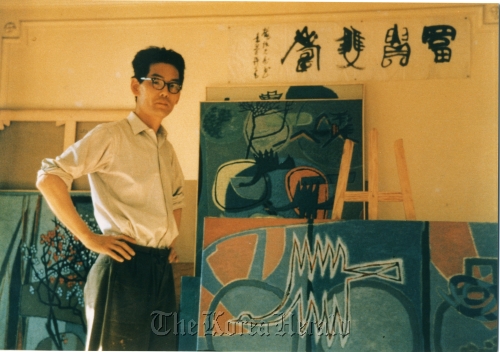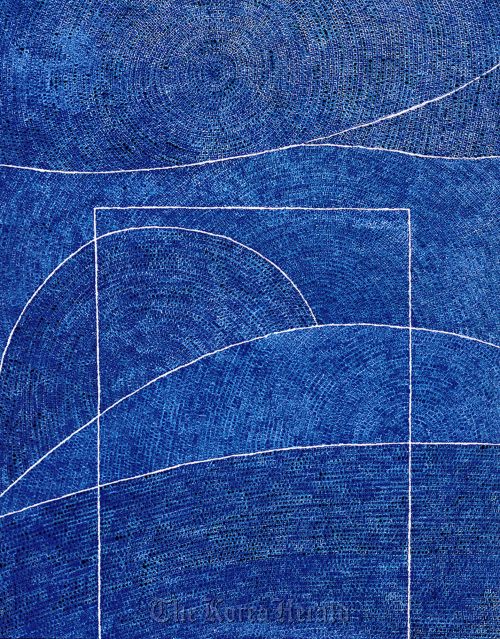 |
“Women, Plum Blossoms and Jar” by Kim Whanki (Gallery Hyundai) |
Gallery Hyundai holds retrospective of late South Korean painter
Kim Whanki was a prolific painter ― he worked in the daytime to make use of the sunshine and at night because the electric light was too precious to waste.
He worked about 16 hours a day, said Kim Geum-ja, the second daughter of the late South Korean, reminiscing in front of press members on Thursday about how stubbornly her father used to work.
“He said that it is his life, to hold a brush. But my heart felt heavy and my pulse raced, as if to burst, when I confronted his dot paintings here today. I wondered if that was the point when he got ill. How difficult a labor it must have been to paint 100,000 dots,” said Kim, her eyes welling up with tears.
“But I guess that is a daughter’s point of view. Hearing this, my friend scolded me for having such a thought. She said I should think how happy he must have been to paint such a great work.”
Art aficionados of today are grateful the artist left so many excellent works. Born in 1913 and dying in 1974 of a brain hemorrhage, Kim is considered one of Korea’s best modernist painters.
He created more than 3,000 works ― more than contemporaries such as Park Soo-keun, who left about 1,000, and Lee Joong-seop, who left fewer than 500. Kim’s works are not only acclaimed by critics but loved by the public as well ― in 2011, pieces by Kim fetched 7 billion won ($6 million) at auction in Korea. This is the highest amount after Lee U-fan, whose work fetched a total 7.3 billion won.
A large retrospective on the artist will kick off at Gallery Hyundai on Friday. It is the third in the gallery’s exhibition series featuring Korea’s modernist masters, after exhibitions for Park Soo-keun and Chang Ucchin. The gallery provided its new and old buildings in Sagan-dong, central Seoul, for the show.
More than 60 paintings are on display, which the organizers said were the most important of those not on show at the National Museum of Contemporary Art or the Whanki Museum in central Seoul. Exhibits include four paintings shown to the public for the first time, including 1950s piece “On the Way Back.”
 |
Kim Whanki at his atelier (Gallery Hyundai) |
 |
“Hundred Thousand Dots” by Kim Whanki (Gallery Hyundai) |
Kim changed his residence many times during his career, working in Seoul, Tokyo, Paris and New York. His style, however, remained quite consistent. The thickness of paint changed slightly ― became thicker in Paris and thinner in New York ― but his simple composition and use of pastel colors like sky blue and light purple remained the same.
Choi Sun-u, late historian and former director of the National Museum of Korea, once told him in the 1970s that “your paintings never change, although most artists’ styles change even after a taste of French water.”
Kim answered “I did not even visit art exhibitions in fear that I may get influenced ― I tried very hard to keep myself.”
Visitors may notice that his consistent style reflects a very “Korean” sentiment, as shown in subjects such as moon jars, plum blossoms and women decked in “hanbok,” or Korean traditional dress.
“My paintings cannot help but be those by an Asian. To be international, one has to be most Korean. Living on an international stage called Paris, I could see our sky and hear our songs more clearly,” Kim had said during his Paris days.
In line with the exhibition, the gallery published an English-language catalogue introducing 140 of Kim’s paintings and several essays by prominent art figures in Korea including Choi.
Yoo hong-jun, former director of the Cultural Heritage Administration, will give a lecture on Kim on Jan. 10 and lead a group tour to the house where Kim was born in Sinan, South Jeolla Province, on Feb. 20. The gallery will also offer guided tours in English on Sundays.
The exhibition will run from Jan. 6 to Feb. 26 at Gallery Hyundai in Sagan-dong. Tickets range from 3,000 won to 5,000 won. For more information, call (02) 2287-3500 or visit www.galleryhyundai.com.
By Park Min-young (
claire@heraldcorp.com)






![[Herald Interview] 'Trump will use tariffs as first line of defense for American manufacturing'](http://res.heraldm.com/phpwas/restmb_idxmake.php?idx=644&simg=/content/image/2024/11/26/20241126050017_0.jpg)

![[Health and care] Getting cancer young: Why cancer isn’t just an older person’s battle](http://res.heraldm.com/phpwas/restmb_idxmake.php?idx=644&simg=/content/image/2024/11/26/20241126050043_0.jpg)

